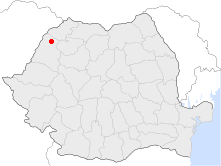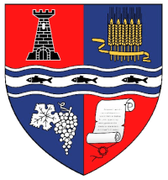Marghita
| Marghita Margitta | ||
|---|---|---|
| Municipality | ||
|
Aerial view | ||
| ||
 Location of Marghita | ||
| Coordinates: 47°21′00″N 22°20′00″E / 47.35000°N 22.33333°ECoordinates: 47°21′00″N 22°20′00″E / 47.35000°N 22.33333°E | ||
| Country |
| |
| County | Bihor County | |
| Status | Municipality | |
| Government | ||
| • Mayor | Zoltán-Ladislau Pocsaly (Democratic Union of Hungarians in Romania) | |
| Population (2011) | ||
| • Total | 15,134 | |
| Time zone | EET (UTC+2) | |
| • Summer (DST) | EEST (UTC+3) | |
| Climate | Cfb | |
| Website | http://www.marghita.ro/ | |
Marghita (Romanian pronunciation: [marˈɡita]; Hungarian: Margitta, Hungarian pronunciation: [ˈmɒrɡitːɒ]; Yiddish: מארגארעטין Margaretin) is a city in Bihor County, Romania. It administers two villages, Cheţ (Magyarkéc) and Ghenetea (Genyéte).
History
The name appears to be derived from the name "Margit" (Margaret), Saint Margaret the patron of a local church. The first time it was used in a document was in 1216. In the 14th century, it became a feudal holding of the Hungarian landlord.
In 1376 king Louis I of Hungary gave to Marghita the right of organizing a fair and it developed in the next centuries as a market town. There were several peasant revolts against the feudal system affecting Marghita in 1467 and 1514. At the beginning of the 14th century, it became, together with the whole of Bihor county and Hungary, an Ottoman province.
In 1823, a great fire destroyed half of the buildings of Marghita. After the 1848 revolution, the local peasants were no longer serfs and manufacturing and industry began to develop. In 1944, after German occupation about 2,100 Jews of Marghita were sent to death, concentration and labor camps as part of the Holocaust, and about 450 from them survived. After 1947 with the Soviets imposing a Communist government in Romania, factories and land were nationalized. Over the course of the next few years, Marghita took part in the Romanian industrialization process.
Politics
The Marghita Municipal Council, elected in the 2012 local government elections, is made up of 17 councillors, with the following party composition:
| Party | Seats | Current Council | |||||||
|---|---|---|---|---|---|---|---|---|---|
| 41.18% | Democratic Union of Hungarians in Romania | 7 | |||||||
| 35.29% | National Liberal Party | 6 | |||||||
| 17.65% | Social Democratic Party | 3 | |||||||
| 5.88% | People's Party – Dan Diaconescu | 1 | |||||||
Population
| Historical population | ||
|---|---|---|
| Year | Pop. | ±% |
| 1977 | 14,589 | — |
| 1992 | 19,071 | +30.7% |
| 2002 | 18,650 | −2.2% |
| 2011 | 15,134 | −18.9% |
| Source: Census data | ||
At the 2011 census, Marghita had a population of 15,134. According to the census, 51.7% of inhabitants are Romanians, 44.1% Hungarians, 3.5% Roma and 0.5% Slovaks.
Sister cities
References
- ↑ "Testvértelepülések". Retrieved 30 April 2014.
External links
| Wikimedia Commons has media related to Marghita. |


